


meet at the bridge around seven. It was all messengers at first, so we all started at the bridge, ended at the bridge.”
Lopez, who has carried on the tradition of Cranksgiving in L.A. since Carr’s passing in 2011, said the race is important to him for several reasons. “The food goes to Para Los Ninos, which [serves] the Westlake area, Rampart, Belmont Heights. I grew up in that area, so the food that we get goes to that organization right there, and then people from that neighborhood actually get the food. The second part is it’s a fun race that Melissa was really into, so I don’t want that to die, because she gave so much to that. She cared about it so much.”
After spreading to Los Angeles—where Cranksgiving has become the city’s longest-running alleycat—the charity race caught on like a slow-moving fire; one, two cities a year at first; then a few more, then half a dozen. While many are modeled after Tone’s Cranksgiving, others uphold their own identity: In Washington, D.C., Neil Irvin and Jason Buda organized Gobbling for Goods for the first time this past Thanksgiving, and in San Francisco Jenny Oh Hatfield is part of a group of cyclists who have coordinated Super Market Street Sweep for the last six years.
“The idea to start The Supermarket Street Sweep came about during an informal online chat on the cycling forum, www.sffixed.com. Several members thought it would be great to throw a holiday event that would benefit the community, and I drew inspiration from the annual Cranksgiving event in New York City, where I lived for 13 years,” Hatfield said. “We decided to change the name and always host our event the first weekend in December, but the concept is essentially the same: racers zipping around San Francisco to pick up groceries from designated supermarkets within a 4-hour time frame. I really love the concept of this race for several reasons: Participants can directly see the benefits of their efforts. It’s not some abstract donation where they don’t know where their money is going. When racers unload their food at the Food Bank and see the number for the total weight of food rising on the scale, they get really excited seeing how much they were physically able to bring in.”
Close to a dozen new cities began hosting their own food drive bike event in 2012. While most organizers model their events after Tone’s, some have chosen to hold Cranksgiving simply as a bike ride and not a race. Bay area participants can choose to race in either a Speed or Cargo category.
“It’s a highly adaptable event,” explains Ken Stanek, who has taken over the reigns in New York since Tone left in 2006. This year’s attendance in NYC jumped by more than 100, to 280 participants. “It was by far the biggest one we’ve had. It’s changing a lot from being a messenger event. It was nuts,” Stanek said. “I have no way of actually knowing how much food we collected,” We filled up a room in the church. The people at the church were so grateful.”
The ride itself can be nuts, too. Racers run in and out of the markets, criss-crossing one another on various paths in the aisles and in the streets, filling up their bags as they go with cans of corn and cranberry sauce, boxes of stuffing, potatoes, celery—all sorts of grocery items. Organizers work with their local charity of choice, whether it be a food bank, soup kitchen or shelter, and are able to meet the specific needs of the organization and their community.
“Since our food pantry only distributes nutritious groceries, I was so glad that the scavenger hunt took our needs into consideration and the collection accurately reflected the items we wanted most,” said Emily Schneider of D.C.’s Bread for the City. The food bank’s wish list included low-sugar cereals, canned tuna, brown rice and baby food. “Those items were immed-
Surly